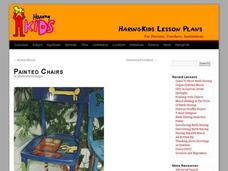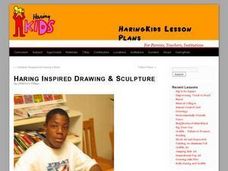Curated OER
Reading Power through Visualizations
Students practice visualizing images as they read in this lesson. Students create an oral collage with their visualizations. Students are then given three separate scenarios to visualize, and are assessed on their description of their...
Curated OER
Measuring Distance and Area in Satellite Images (College Level)
Students are able to download, install, and use Image J image analysis software to quantify change over time in satellite images. They access and download satellite images for specific locations and times. Students set a scale (spatial...
Curated OER
Comparison of Snow Cover on Different Continents
Students use the Live Access Server (LAS) to form maps and a numerical text file of snow cover for each continent on a particular date. They analyze the data for each map and corresponding text file to determine an estimate of snow cover...
Curated OER
Visual Literacy
Students focus on visual literacy in this lesson which can be incorporated to any previous lesson. Using images, they identify the visual elements and design in them and examining the various patterns present. In groups, they discover...
Curated OER
The Death of Old Woman Kelema
Young scholars read various parts of "The Death of Old Woman Kelema". Next, they listen to the author's description of her writing process. In groups, they compare and contrast funerals in Mali with those in the United States. They also...
Curated OER
Art and Culture
Students compare and contrast the ways in which human figures are portrayed in rock art made by ancient Native American artists and in the drawings and paintings of historic European and American artists. They use images to identify...
Curated OER
Those Cells Look Good Enough to Eat
Young scholars explore the parts of the cell. In this cell lesson, students use foods to create cell models that represent the nucleus, cytoplasm, cell membrane, mitochondria, ribosomes, vacuoles, endoplasmic reticulum, and Golgi bodies...
Curated OER
Changes in Latitudes, Changes in Attitudes
Sixth graders discuss how people, society, and technology change over time through a unit of integrated lessons. In these changes in society lessons, 6th graders discuss the answers to many questions about how changes effect the...
Curated OER
Using Onomatopoeia to Tell the Story of an Imaginary Field Trip
Students explore language arts by utilizing word choice to compose a paragraph. In this phonetics lesson, students discuss the importance of a "voice" in their writing as they read the book Rattletrap Car. Students write paragraphs about...
Curated OER
Introduction to Earth's Dynamically Changing Climate
Students identify the most common causes of global warming. In this earth science lesson, students use an interactive website to explore changes over time in sea ice, sea level, carbon emissions, and average global temperature. They take...
Curated OER
Painted Chairs
Students evaluate visual arts by creating furniture designs. In this three dimensional art lesson, students utilize the web to examine different artist renderings of furniture, sculpture and architecture. Students utilize paint to create...
Curated OER
Haring Inspired Drawing and Sculpture
Students research art by identifying the work of Keith Haring. In this sculpting instructional activity, students utilize the web to examine sculptures and drawings in the style of Keith Haring. Students utilize sculpting wire, foil,...
Curated OER
Develop Your Own Interpretation
Students use pieces of Andy Warhol's art to write critiques. Using different points of view, they answer discussion questions and share them with the class. They also interpret the art from a historian and artist point of view. They...
Curated OER
When is Dinner Served? Predicting the Spring Phytoplankton Bloom in the Gulf of Maine (College Level)
Students are able to explain the ecological importance of phytoplankton. They describe the components that influence a phytoplankton bloom. Students interpret satellite images in order to correlate buoy data.
Curated OER
Life Sized Self Portrait
Students create a self-portrait that is compiled by using individual student drawings. The drawings emphasize line, shape, color and possibly texture depending upon the student's selection of materials.
Curated OER
Africa's Geographic Features
Fourth graders work in pairs and use atlases to locate specific geographic features in Africa. They use the Internet to view these geographic features.
Curated OER
Creating and Analyzing Graphs of Tropospheric Ozone
Students create and analyze graphs using archived atmospheric data to compare the ozone levels of selected regions around the world.
Curated OER
Linkages Between Surface Temperature And Tropospheric Ozone
Students organize and analyze data regarding changes in tropospheric ozone and then hypothesize about the consequences of these changes.
Curated OER
Biology: Butterfly Activities
Second graders examine various types of butterflies and insects around their school. They identify differences between beetles and butterflies. Students examine books about butterflies, complete symmetry drawings, and make ladybug key...
Curated OER
Native American Images in the Media
Pupils examine various images of Native Americans in the media. In groups, they create a list of present Native American stereotypes and what the media did to continue the stereotype. To end the lesson, they write in their journals...
Curated OER
The Invisible Zoo
Pupils explore how infrared images give biologists or zoologists detailed information on how warm-blooded and cold-blooded animals thermoregulate. They are introduced to infrared imaging technology and the information that such images...
Other popular searches
- Imagery Figurative Language
- Visual Imagery
- Guided Imagery
- Imagery and Poetic Devices
- Imagery Words
- Imagery and Word Choice
- Plot Structure and Imagery
- Imagery the Great Gatsby
- Literary Imagery
- Teaching Poetry Imagery
- Satellite Imagery
- Musical Imagery






















